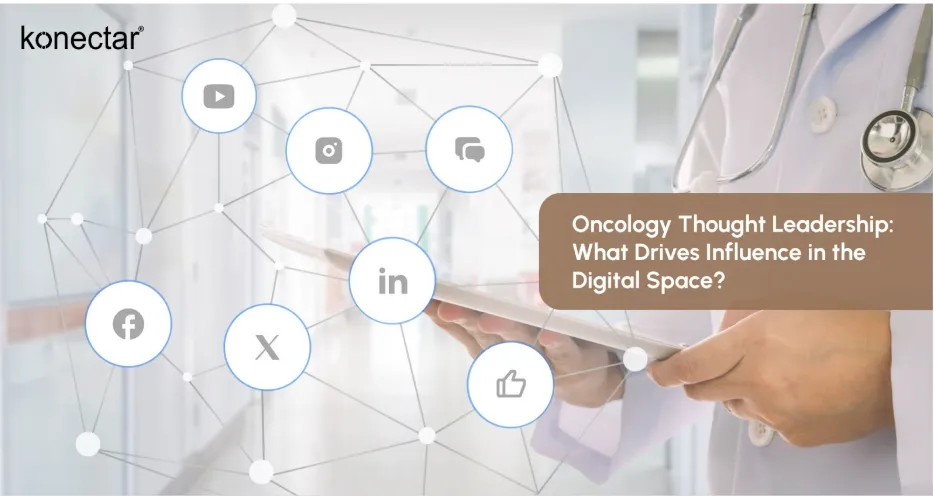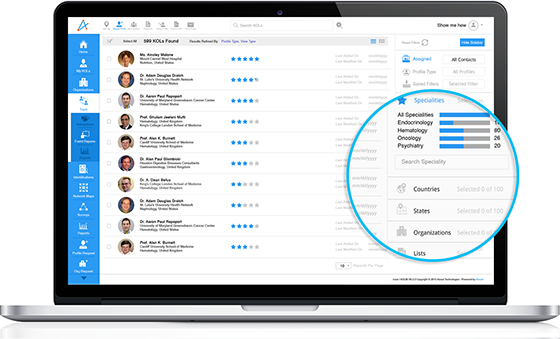08-10-2025
Oncology Thought Leadership: What Drives Influence in the Digital Space?

Oncology thought leadership has extended far beyond traditional academic and clinical settings. Influence once stemmed from publication count or speaking engagements, but a new digital era has emerged—one shaped by social media in healthcare, virtual collaborations, and real-time conversations.
Oncology is at the forefront of scientific innovation, driven in part by ongoing healthcare digital transformation. Experts are showing up where the conversations are, and they are influencing how people think, engage, and act—digitally. In a fast-moving field as oncology, access to timely and relevant insights matters more than ever.
In This Article:
- Thought Leadership Is Outgrowing Podiums
- Challenges in Measuring Digital Influence
- Tools & Strategies for Identifying Digital Thought Leaders
- Conclusion
- FAQs
Thought Leadership Is Outgrowing Podiums
Some time ago, influence in oncology followed a linear route. It started with getting published in prestigious journals, getting invited to highly regarded conferences, and getting quoted. Pharma teams built long-term relationships with a small circle of high-profile oncology Key Opinion Leaders (KOLs). This approach worked because the ecosystem was slower, more siloed, and highly centralized.
Today, the rise of digital engagement in oncology has made the landscape more dynamic. In addition to established names, forward teams are identifying digital opinion leaders in oncology—professionals who combine clinical expertise with consistent, online credibility. Many operate as medical digital influencers cultivating trust and authority through targeted engagement that reaches not only peers but also patient advocacy groups and policymakers.
This comparison of the thought leadership landscape will provide a clearer picture:
Challenges in Measuring Digital Influence
As digital engagement grows more sophisticated, so does the difficulty of measuring its actual impact, especially in a highly regulated field of oncology. While vanity metrics like follower counts and impressions are easy to track, they often mask the more nuanced indicators of actual influence.
Overreliance on Surface Metrics
Many platforms promote visible indicators (likes, shares, retweets), but these don't necessarily correlate with credibility or decision-making power. A post going viral doesn’t make its author a thought leader, especially in a clinical context where accuracy outweighs popularity.
Influence is Specialty-Specific
Influence is highly contextual. A leading voice in breast cancer may not carry similar weight in other areas. Yet, many digital measurement tools apply generalized scoring models that fail to account for subspecialty relevance, audience type (peers vs patients), or geographical reach.
Activity ≠ Authority
Frequent posting can create an illusion of expertise. True digital authority stems from engagement quality, content depth, and peer recognition, not sheer frequency. The most impactful voices may post less frequently, but their content may have higher strategic intent and resonance.
Tools & Strategies for Identifying Digital Thought Leaders
Finding the right oncology thought leaders in the digital space requires more than simply browsing social media or looking at conference speaker lists. This process needs to be data-driven, specialty-specific, and aligned with the organization’s strategic objectives.
Effective judgement combines qualitative judgement—assessing a leader’s credibility, tone, and relevance with quantitative analytics—tracking reach, engagement, and network influence.
Define Your Influence Criteria First
Before investing time in data gathering, clearly define what “influence” means for your objectives. In oncology, this might include:
- Specialization in a relevant therapeutic area.
- Digital engagement with peers, patients, and advocacy groups.
- Geographic or market relevance.
Leveraging konectar Social for Precision
konectar offers a comprehensive approach to identifying and profiling thought leaders by merging traditional authority markers (publications, conference participation, clinical experience) with real-time digital activity.
With konectar Social, teams can capture live signals from oncology Digital Opinion Leaders (DOLs)—the voices shaping conversations around trials, abstracts, and guidelines.
Key capabilities include:
- Therapeutic Area Filtering: For pinpoint accuracy in sub-specialties like hematology or rare cancers—augmented by konectar Social to track who’s driving discourse across relevant hashtags and events.
- Unified Influence Profiling: That integrates social engagement, scientific contributions, and event presence into a single view.
- Engagement Statistics: Showing not just reach, but the quality and type of audience interaction; konectar Social adds real-time DOL activity to highlight consistency and momentum.
By combining granular filters with aggregated influencer data, konectar Social enables teams to spot rising voices early and prioritize outreach to those with genuine impact.
Continual Monitoring and Recalibration
Influence is dynamic. A leader who is highly active during a conference season may shift afterwards, while emerging voices can gain relevance quickly. Regularly reviewing and updating your influencer map ensures you stay aligned with current conversation drivers and maintain engagement with the most impactful voices.
Ready to discover the most influential voices shaping oncology conversations online?
With konectar Social, don’t just follow the conversation—lead it.
Book a demo today.
Conclusion
Digital influence in oncology is no longer defined solely by credentials or stage presence—it's the product of scientific integrity and meaningful engagement across multiple channels. For medical affairs, this means moving beyond static lists to a data-driven approach.
By leveraging konectar Social teams can pinpoint the right influencers, understand their true impact, and build partnerships that last.
FAQs
- What is a Digital Opinion Leader in oncology?
A DOL is an oncology expert—clinician, researcher, or advocate—who shares credible, timely insights via digital platforms. DOLs leverage digital media to translate complex clinical data into accessible content.
- How can organizations identify relevant oncology DOLs?
Effective identification requires a mix of traditional authority and digital presence. konectar Social aggregates this data in a single unified view.
- Is it enough to rely on follower count or likes to measure influence?
Not at all. Simple metrics like follower count and likes can be misleading. Focus on factors that go beyond vanity metrics.





